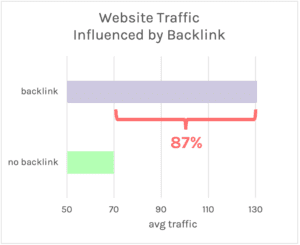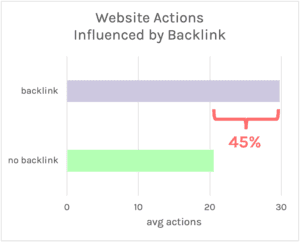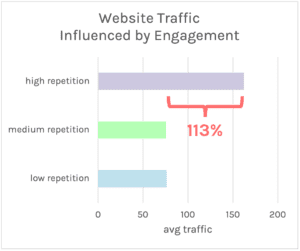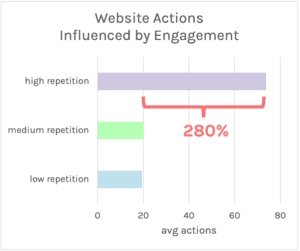Welcome back to our blog series about the relationship between core earned media attributes and consumer behavior! These insights are based on our quantitative analysis of the PR Attribution™ data from over 100,000 earned media articles published in 2021. It covered both business-to-consumer and business-to-business brands across a wide range of industries. This week, our focus is shifting to the topic of brand engagement.
Last week, we talked about brand relevance, which didn’t turn out to be a strong driver of consumer behavior. We’re about to reveal if brand engagement is more predictive of website traffic and actions. Read on to learn more!
Presence of a backlink and consumer behavior
We define a backlink as a link to a brand’s website that is embedded in a media article mentioning that brand.
Not surprisingly, the presence of a backlink is highly correlated with website traffic. On average, we see traffic increase by 86.8% when a backlink is present in an article.
The presence of a backlink is less predictive of website actions performed by those website visitors. That said, on average, backlink presence still drives 44.9% more actions than no backlink presence.


The takeaway? The fact is, there is not much you can do to influence whether a published article about your brand includes a backlink or not. While the data above suggest you should certainly request it, the presence of a backlink in your earned media content remains within the publication’s control.
Social media engagement and consumer behavior
Social media engagement represents the number of likes, shares, comments, re-tweets, re-pins, and other social media interactions that a media article receives on a social network.
Drum roll, please! Of all the media characteristics we analyzed, the level of social media engagement emerged as the biggest predictor of the volume of website traffic. Highly engaged articles drove 113% more website traffic than low engaged articles.
The correlation is even more pronounced when it comes to website actions, with highly engaged articles driving 279.52% more website actions than low engaged articles.
Although not a big surprise given that social engagement is an indicator of the content’s resonance with its readers, we still didn’t necessarily expect this to be the biggest driver of consumer behavior. Once again, hard data from PR Attribution™ has proven to be full of unexpected insights.


“Action begets more action. Once we have made a choice to engage with a media article, for example by sharing it on social media, we are more likely to behave consistently with that choice by performing additional actions like visiting the website of the company mentioned in that article.”
– Frank Mulhern, PhD, Associate Dean and Professor at Northwestern University’s Medill School of Journalism, Media and Integrated Communications
To capitalize on social media engagement as an extraordinary driver of brand website visitors and desired actions, subscribe to a comprehensive media monitoring or social listening service, like Onclusive. With this advanced technology, you’ll be able to consistently track which content your audience engages with the most. You can then produce more content like that in order to increase your brand’s website visitation.
Want more insights?
Stay tuned for our final article in the series, where we will take a look at the relationship between brand sentiment and consumer behavior. This one is the most unexpected finding of all. Plus, we’ll share the summary of the key takeaways from our research.
Join Onclusive for the How Earned Media Drives Consumer Behavior: A Quantitative Analysis webinar on June 8th . Our panel of communications and data experts will reveal which media attributes – such as publication authority, reach, article relevance, brand sentiment and reader engagement – are key to driving action from your audience. We’ll also discuss how this data can help you improve your communications performance.
